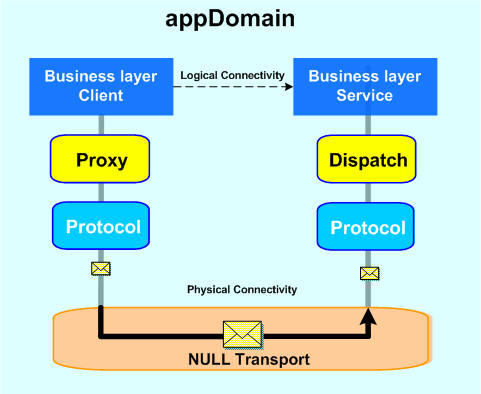IntroductionThe Microsoft Windows Communication Foundation (WCF) represents a logical model of connectivity, where the connectivity between the service and its consumer is abstracted to the stack of the channels on top of the physical transport layer. Based on the binding stack elements and physical transport on both ends of the connectivity, we can define how the message can flow between the business layers in terms of the message exchange pattern (MEP). Note, the business layers do not need to know about each other, such as where they are hosted, located and connected, therefore we can say, the business layers are logical connected. The business connected layers represented by the client (proxy) and service can live in the same appDomain or on the different appDomains in the same process, out of the process or across the machine. Having the logical connectivity model in the application architecture enables it to encapsulate the business layers from the connectivity driven by the metadata. The WCF model introduces several common transports and bindings to create a sync and async connectivity with a variant of the message exchange patterns such as Input/Output, Request/Reply, Session, Duplex, etc. over the different physical transports such as TCP, HTTP, MSMQ, Pipe, etc. It is a great open connectivity paradigm with the ability to customize and extend all elements based on the business needs. Based on the physical transport, the business can live in the same tier or can be decoupled across an Enterprise Network using the principle of the Service Oriented Architecture (SOA) tenets.This article is focused on the WCF connectivity model within the same appDomain. The current version of the .netfx 3.0 and also upcoming version 3.5 (Orcas) uses the named pipe for in-process communication between the service and its consumer. The Transport layer will take this binary stream or formatted text over the appDomain using a specific physical media, in our case it is a local Named Pipe running in the kernel mode, which can be reachable by any process on the same machine. The service's Encoder must decode the incoming stream/text into the message object and pass it to the Protocol channels. At the end, the Dispatch's Operation Invoker will invoke a method on the service instance. So far so good, the netNamedPipeBinding allows to connect and transport binary message object using the local named pipe resource via a kernel mode between the service and client in a fast and reliable sync/async manner. So, what is the point? The point is described in the following picture; if the client and service are located in the same appDomain. Do we need to go out and back into the same appDomain to handle the internal domain communications via inter-process kernel resources? The following picture can answer for in-process connectivity:
Read more: Codeproject

Read more: Codeproject



0 comments:
Post a Comment